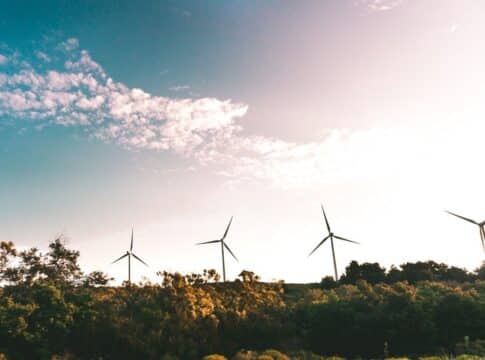Carbonized Crypto, Part 3: Leading Carbon Crypto Projects
Harness the blockchain, verify carbon credits, and solve two problems with one cutting-edge stone. All the projects on this list promise some variation on that idea; the only challenge is putting everything into practice in a market-friendly, cost-efficient way.
Here are current carbon crypto projects that are generating buzz and drawing some attention. Not all of them are equally successful, and few have established anything like a long-term track record. But all of them offer
Moss
Moss is two projects in one: a popular token (MCO2) and a climate-based NFT project. Both projects rely on the concept of tokenization to incentivize carbon offset production and emissions reduction.
The MCO2 token is available as an ERC-20 token on popular exchanges such as Coinbase. Purchase of the token (trading at $11.46 at time of writing) funds carbon offset projects. Most are based in and around the Amazon rainforest.
Moss doesn’t administer offset projects directly. Instead, they source high-quality offsets from other providers and tokenize them. Each project results in a given amount of offsets; Moss produces a set amount of tokens based on the projected offsets. One MC02 token = an offset for one tonne of CO2.
By burning MC02 tokens, Moss locks in offset projects permanently, reducing the overall supply of offsets in the market and boosting the price of remaining offsets.
The Moss Amazon NFT project operates a bit differently. Moss purchases portions of the Amazon that are at-risk for deforestation. That land is then divided into 1-hectare portions, each roughly the size of a football field. The rights to those portions are digitized and tokenized as NFTs (Non-Fungible Tokens). Each NFT is unique and tied to a unique piece of property.
The Moss Amazon NFTs are actual land sales; proceeds from the sales fund further purchases, with 30% of the proceeds going to a preservation fund. That fund pays for patrolling and physically protecting the Amazon NFT holdings.
Moss distinctives:
Amazon NFT based on actual ownership
Due diligence for purchase and enforcement
Part of the Celo Reserve, supporting a climate-based stablecoin (cUSD, cEUR)
Brazil-based
KlimaDAO
Read the documentation.
KlimaDAO is nothing if not ambitious. Built on the common crypto carbon model of tokenized carbon offsets, Klima is also a DAO. As a Decentralized Autonomous Organization, KlimaDAO aims to boost the price of offsets on the VCM. This is done by purchasing carbon offsets, tokenizing them, and then selling or burning them to influence the market.
What sets Klima apart is its stated goal to be a carbon-backed currency, rather than simply a marker for credits held in reserve. To that end, all KLIMA tokens are backed 1:1 by reserve holdings in BCT, tokens issued by Toucan (see the next review).
Put more simply, to mint more KLIMA tokens (and increase supply), KlimaDAO needs to lock away BCT (Basic Carbon Tonne) in the treasury. KLIMA is pegged to BCT 1:1, and BCT is pegged to real-world offsets. Klima’s treasury functions as a blackhole for BCT and carbon offsets, removing them from the market and pushing the real-world carbon price higher.
The DAO structure allows holders of KLIMA to participate in Klima’s governance. Holders can propose new measures and vote on their passage.
KlimaDAO Distinctives
DAO structure and governance
KLIMA as the currency of a new, carbon-based ecosystem
Pegged to the BCT
Toucan
It’s not enough to describe Toucan.earth as a crypto carbon project; Toucan is more about bringing a number of related projects together, each with their own distinctives.
Toucan is more accurately described as a bridge. Toucan links the Web3 architecture to the decarbonization push. Put another way, Toucan forms the base of a new, carbon-focused Web3 stack.
The core of Toucan’s project is the TCO2, which simply stands for Tokenized CO2. Each TCO2 represents one verified, real-world carbon credit. TCO2’s are semi-fungible, with unique information about each project encoded on-chain. The tokens are Verra verified, linking Toucan to one of the premier carbon offset standards.
Most projects planned for the Toucan stack won’t use the TCO2 directly. Trading TCO2 tokens one-for-one isn’t always possible, simply because the projects each token represents are different. To achieve the necessary liquidity for market projects such as Klima, the TCO2 tokens are fractionalized and pooled.
The first such pool was the Klima/Toucan project, which created the Base Carbon Tonne (BCT). Each BCT token isn’t tied to a specific offset project, allowing them to be traded one-for-one. But all BCT tokens are still backed by verified projects, because of the use of TCO2.
The pooling process is known as gating, and projects are able to set parameters for which TCO2 tokens they’ll allow into the pool. The Klima/Toucan project only created BCT from Verra-approved offsets created after 2008. Gating would allow other carbon crypto projects to be more narrowly focused, all while maintaining an approved and verified link between their tokens and real-world projects.
Toucan forms the foundation for a Web3 carbon crypto stack. Projects like KlimaDAO build on that stack. Tokenized carbon credits are the key.
Toucan.earth distinctives
TCO2 token
Token pooling and gating; BCT token
Development of a Web3 carbon crypto stack
SavePlanetEarth
Read the whitepaper.
SavePlanetEarth’s self-description captures it all: a “carbon sequestration crypto project.” Structurally, SavePlanetEarth shares similarities with the Toucan/Klima project. The base of the project is tokenization of verified carbon credits, on which an entire ecosystem will be built – a currency and a blockchain powered by green energy.
There are a few key differences; the base token is $SPE, and the verification standard used for the carbon offsets is the Gold Standard, rather than Verra. The SPE project also relies more heavily on NFTs for the initial stage of project management, as well as something called “carbon credit certificates.”
The SPE roadmap includes a multi-level exchange, powered by the $SPE currency, where carbon credits can be bought and sold. It will also encourage external investment by allowing companies to trade their own credits on the exchange, once verified by SPE.
SPE distinctives
Phantasma blockchain (with native SPE blockchain in development)
Carbon-based exchange in roadmap
Uses The Gold Standard verification
Projects conform to all 17 of UN Sustainable Development Goals
Other notable projects:
Not every project is as well-developed as the ones above. Some are in the early stages, while others are more narrowly-focused. Here are a few significant projects to keep in mind.
AirCarbonExchange
AirCarbonExchange made the news by helping Abu Dhabi’s financial sector achieve full carbon neutrality. As an exchange, ACE sources carbon offset projects and tokenizes them into several different tokens, each tailored to a specific sector of the market. There’s no broader plan; AirCarbonExchange exists to facilitate the adoption of carbon crypto tokens as a commodity, and to trade them accordingly.
See how it works here.
Base
Base Carbon focuses on funding and support for developing crypto carbon projects. It also serves to source and verify suitable projects for entry into Toucan’s TCO2 and BCT programs.
Details at the link.
CarbonTokenProject
Tokenization on the smallest scale – the trees in your backyard. CarbonTokenProject uses an innovative approach of human verification, data oracles, and the blockchain to tokenize trees. With its innovative approach, CarbonTokenProject is probably the first grassroots (treeroots?) carbon crypto initiative.
Read more here.
KumoDAO
Another crypto carbon currency, but with a twist: KumoDAO aims to be a USD-pegged stablecoin. Stablecoins pose unique technical challenges, but offer increased ease of use with the traditional monetary system. KumoDAO is in the early stages, part of a wave of carbon crypto projects begun in the wake of KlimaDAO’s launch in 2021.
More info here.
The post Carbonized Crypto, Part 3: Leading Carbon Crypto Projects appeared first on Carbon Credits.



